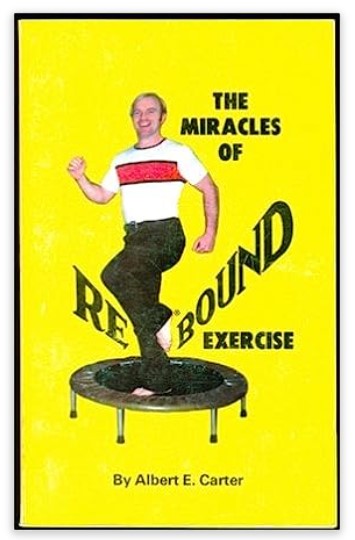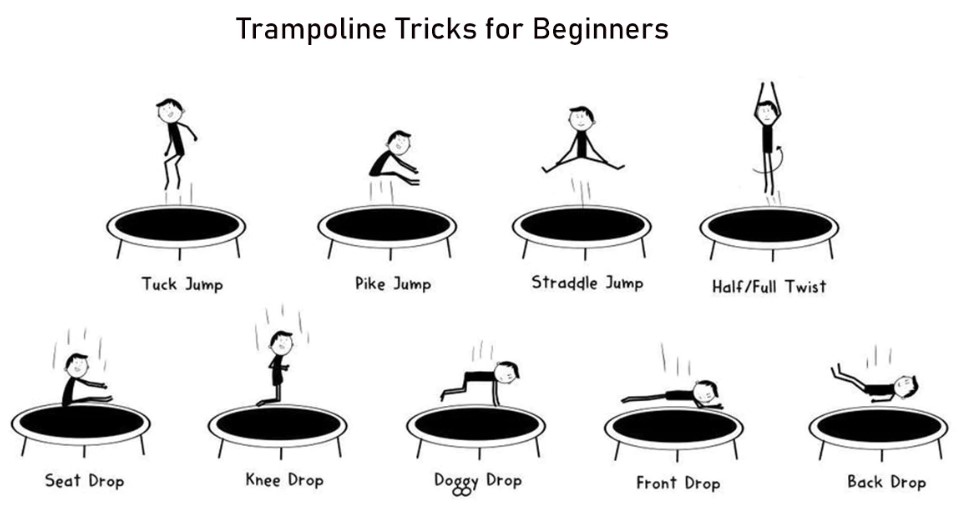I use rebounding (bounce back chair inside / mini-trampoline outside porch) daily. This exercise is effective and actually enjoyable, while being gentle on these senior bones.
33 Ways the Body Responds to Rebound Exercise
By Dr. Morton Walker and Albert E. Carter
StephenCabral.com
Studies described and documented in the book The Ultimate Exercise for the New Millennium, proves regular rebounding can reduce your body fat, firm your arms, benefit the shape of your legs, hips and abdomen, improve your balance, stimulate your lymphatic system, protect your joints, strengthen your muscles and bones without the trauma of hitting a hard surface, provide an aerobic effect for your cardiopulmonary systems, revitalize your body when it’s tired, and generally put you in a state of mental and physical wellness!
Rebounding provides an increased G-force (gravitational load), which benefits the body by strengthening the musculoskeletal systems.
Rebounding protects the joints from the chronic fatigue and impact delivered by exercising on hard surfaces.
Rebounding helps manage body composition and improves muscle-to-fat ratio. Rebound Exercise benefits you by giving you more control over these.
Rebounding benefits lymphatic circulation by stimulating the millions of one-way valves in the lymphatic system. This benefits the body’s immune capacity for fighting current disease, destroying cancer cells, eliminating antigens and preventing future illness.
Rebounding circulates more oxygen to the tissues.
Rebounding establishes a better equilibrium between the oxygen required by the tissues and the oxygen made available.
Rebounding increases capacity for respiration.
Rebounding tends to reduce the height to which the arterial pressures rise during exertion.
Rebounding lessens the time during which blood pressure remains abnormal after severe activity.
Rebounding assists in the rehabilitation of existing heart problems. Rebound Exercise also benefits recovery from heart procedures, providing gentle, low impact circulation.
Rebounding increases the functional activity of the red bone marrow in the production of red blood cells.
Rebounding gradually improves resting metabolic rate so that more calories are burned for hours after exercise. Related, Rebound Exercise benefits the post-exercise “Glycogen Replenishment” process.
Rebounding causes core muscles and large muscle groups to contract, resulting in the rhythmic compression of the veins and arteries, which more effectively moves fluids, both blood and lymphatic, through the body and back to the heart, lowering peripheral blood pressure and lightening the heart’s load.
Rebounding decreases the volume of blood pooling in the veins of the cardiovascular system preventing chronic edema.
Rebounding encourages collateral circulation by increasing the capillary count in the muscles and decreasing the distance between the capillaries and the target cells.
Rebounding strengthens the heart and other muscles in the body so that they work more efficiently.
Rebounding gradually allows the resting heart to beat less often. Regular Rebound Exercise has been shown to benefit the heart rate, resulting in favorable decreases in resting heart rate.
Rebounding lowers circulating cholesterol and triglyceride levels.
Rebounding lowers low-density lipoprotein (bad) in the blood and increases high-density lipoprotein (good) holding off the incidence of coronary artery disease.
Rebounding promotes tissue repair.
Rebounding for longer than 20 minutes at a moderate intensity at least 3x per week increases the mitochondria count within the muscle cells, benefiting in total endurance. Perhaps you will easily skip those naps.
Rebounding benefits the alkaline reserve of the body, which may be of significance in an emergency requiring prolonged effort.
Rebounding improves coordination between the propreoceptors in the joints, the transmission of nerve impulses to and from the brain, transmission of nerve impulses and responsiveness of the muscle fibers.
Rebounding improves the brain’s responsiveness to the vestibular apparatus within the inner ear, thus improving balance.
Rebounding offers relief from neck and back pains, headaches, and other pain caused by lack of exercise. Rebound Exercise has been shown to benefit body alignment and posture.
Rebounding enhances digestion and elimination processes.
Rebounding allows for deeper and easier relaxation and sleep.
Rebounding results in better mental performance, with keener learning processes.
Rebounding curtails fatigue and menstrual discomfort for women.
Rebounding minimizes the number of colds, allergies, digestive disturbances, and abdominal problems.
Rebounding tends to slow down atrophy in the aging process.
Rebounding is an effective modality by which the user gains a sense of control and an improved self image.
Rebounding is enjoyable!

STRESS REDUCTION
STIMULATES LYMPHATIC FLOW / STIMULATES BLOOD FLOW
OVER-ALL CIRCULATION – This will help with over-all circulation of fluids in the body, and will improve relaxation and reduce stress.
◄ Breathe deeply – good breath control is important for good circulation for both blood and lymphatic fluids.
◄ You can leave your arms dropped to your sides for good relaxation and stress reduction.
◄ To activate the lymphatic flow you should work up to the point that you can continue the bounce from 3 minutes to 10 minutes then to 20 minutes per day.
◄ The first 20 minutes burn carbohydrates, then you will start burning fat.
◄ Remember your Bounce Back Fitness Chair is an excellent resting chair to swing and rock.
